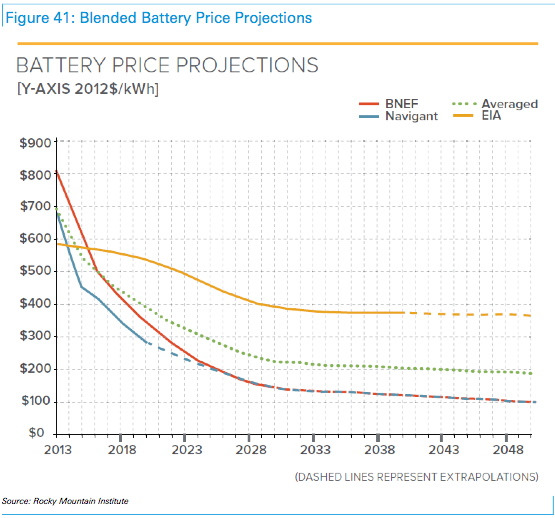The missing link of mass solar adoption – cost-competitive energy storage – will be ready to be deployed on a large-scale within the next five years, according to a new report from Deutsche Bank.
The 175-page solar industry report, published on Friday, describes economically competitive batteries as the “killer app” and the “holy grail” of global solar penetration.
But with many costs already lower than published literature would suggest, Deutsche Bank believes this ultimate solar and renewable energy goal might not be far out of reach.
“Using conservative assumptions and no incentives, our model indicates that the incremental cost of storage will decrease from ~14c/kWh today to ~2c/kWh within the next five years,” the report says.
“When overall system cost decreases are considered, we believe solar + batteries will be a clear financial choice in mature solar markets in the future.”
Currently, according to Deutsche, the cost of a typical lead-acid battery may be as low as ~$200/kWh, while best in class lithium-ion technology was producing commercial/utility packages in the ~$500/kWh range at end 2014 – half the cost of the ~$1000/kWh 12 months prior.
“We believe 20-30 per cent yearly cost reduction is likely (for lithium-ion batteries), which could bring (them) at commercial/utility scale to the point of mass adoption potential before 2020,” the report says.
Deutsche points to the commercial-scale solar market as one of the first areas where battery deployment will flourish, due to clear economic rationale.
“Commercial customers are often subject to demand based charges, which can account for as much as half of the electric bill in some months,” Deutsche says.
“We think companies with differentiated battery solutions coupled with intelligent software and predictive analytics that work with the grid to avoid these charges and smooth electric demand will pave the way for mass adoption.”
The report also points to utilities as a major market for batteries on a large scale, as costs drop and distributed renewable energy generation deployments increase.
On the residential level, the report said households were still unlikely to go down the energy storage path in the short term, without proper pricing mechanisms in place, or access to solar plus storage energy packages.
But again, Deutsche sees this as as a major, untapped opportunity for utilities: “Over the next decade, we see a substantial opportunity for utilities to utilize smart grids through residential battery aggregation.”
Properly incentivised, the report says, utilities could begin to aggregate neighborhoods of solar + batteries to behave as a single source of load reduction.
“Batteries could be dispatched as needed to reduce peak demand across the system. In a high grid-penetration scenario, this could reasonably lower the necessary capacity from conventional generation sources.
“In turn, we think it is reasonable to hypothesize that lowered capacity needs from lowered peak demand would simultaneously lower the need for large up front capital investment in peaker plants.”
Deutsche sites two likely scenarios that would enable this sort of utility-driven household battery deployment: Third party leasing companies and individuals work with the utilities; or a shift in regulatory framework that allows utilities to include residential solar in their rate base.
“Both of these scenarios would likely significantly improve reliability, enable microgrids to function as needed, and improve grid resiliency during emergency situations,” the report says.
© 2015 Solar Choice Pty Ltd
